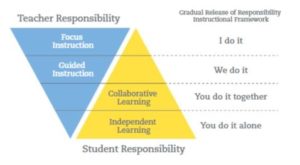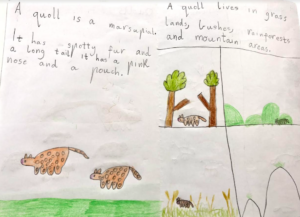Developing Literacy Skills through Modelled Reading

Learning to read is one of the most exciting skills to master for our Prep to Year 2 girls. It is a great joy to work alongside each of the girls, supporting them in developing their reading and writing skills, and watching them emerge into independent and confident readers and writers.
Within Barbreck, the literacy skills of our girls are developed and extended through our Barbreck Academic Strategy. A key component of this Strategy is our Gradual Release of Responsibility (GRR) approach. This pedagogical approach is defined by teacher-led instruction, providing modelling, scaffolding and guidance of students through to independent practice.
This approach enables us as teachers to build the confidence of each of our students within the girls’ own learning levels and academic pace.
Within Year 1 this week, the use of the GRR approach was used to extend the girls’ literacy skills in listening, comprehending, writing, and re-telling as they explored the lives of a platypus, saltwater crocodile, cassowary, and quoll.
Through teacher-led modelled reading the girls listened to texts about the animals that were too difficult for them to read independently. The girls listened to the facts about each animal and recorded relevant information on data sheets, which they later used to write a short information report on one of the animals.
Through the modelled reading approach, the girls’ understanding about reading was further extended through:
- Fluent and expressive reading
- Modelling of comprehension of unfamiliar or complex vocabulary
- Discussion on their thought processes when comprehending a text
- Explanation on the composition of pages, the use of visuals and the elements of the text structure
One of the greatest benefits of modelled reading is the shared experience between the competent reader and the active listener. This experience can be between a teacher and students or caregiver and child. Below are some suggestions from our Head of Barbreck, Ms Karen McArdle, on supporting literacy development at home.
Supporting Literacy Development at Home
A wonderful way to provide ongoing literacy support to your daughters is through shared reading. Sharing a story with your child is one of the great delights of being a parent. From the first time you read a story with them, a special bond is formed – sharing the wonders of imagination, creativity, knowledge, and humanity, all communicated through the written word.
Early stories are designed to entertain and educate. Stories such as Brown Bear-Brown Bear What do you See? The Very Hungry Caterpillar and Hairy Maclary from Donaldson’s Dairy – just to name a few of my favourites!
Reading together provides quiet moments to share with your child. A time when they have mum, dad, or special adults in their lives to themselves. It offers a time to talk about the pictures and words, discovering and exploring what they mean and how they may relate to our own lives and recalling shared experiences.
Story time provides opportunities for your child to discover special interests. A love of animals can be enriched through books, as can a love of baking. These books can springboard into trips to the zoo or baking in the kitchen, creating many additional activities that can be explored together.
Reading can also encourage children to challenge themselves. Stories can stimulate the adventurous spirit within us all, encouraging us to step outside our comfort zones, just like the characters we enjoy reading about.




